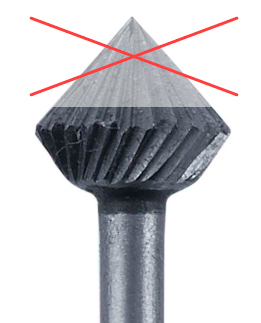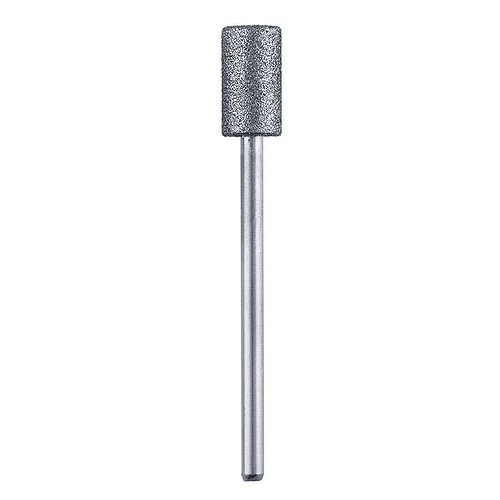In an ongoing effort to add color to some of my work, I want to include small (6-8 MM) round faceted and cab shaped stones. Right now I make all of my 8 MM bezels for cabs and set with a hammer and brass punch. While I have never set a faceted stone, I know what I need to buy and learn how to use to do tube and flush settings, but I don’t know what to use to cut the flat seat for a cab. I could see using a small end mill or modifying a burr in someway, but before I do, does anyone have a suggestion? I have read what I can find in the archives and there is a lot about faceted stones, but nothing that I could find about cutting a flat seat. Thanks…Rob
I’m certainly no expert but I have made my own bezels for little round cabs using a thin-walled tube on the outside and a thicker- walled tube inside for the cab to sit on. They are soldered together and the height is trimmed to what is required.
I hope this helps.
den
I have set many small cabs, I use fine silver tubing. Since i do not have open backs i punch out discs from lids of yogurt containers to get them at the right height. This also acts as a cushion. For translucent stones i use cut out discs of mylar that acts as a mirror. Good luck. Vince Larochelle
Denny and vlarochel…Thanks for your replies. I set lots of cabs with a a backing where the cab sits on the backing or on shims that sit on the backing. What I am trying to figure out is the tooling needed to tube set a cab in the same way that a faceted stone is tube set. My question is how to cut the square seat? I have been looking at small square end mills, but wonder if there is a burr that will do this either out of the box or one that can be modified. Note, I cut my own cabs and can keep the shape of the girdle a little sharper than most small tumbled cabs. I just glue a small piece of rough from a slab to the end of a metal rod smaller in diameter than the finished cab. Nails work well for this. Chuck the other end of the rod into a cordless drill, pull the trigger and hold the cab rough against the grinding wheel until the rough is round and a bit bigger than the finished cab. Don’t remove the rod as you will lose the index that created the round shape. Just work my way down the wheels until it is ground, sanded and polished. This only works for round cabs, but it works well. Heat the rod and the cab falls off. Thanks…Rob
Hi Rob,
If you don’t like the idea of constructing a step bezel with a wire or sheet shoulder inside your bezel, consider making a seat just as one would in the appropriate tubing in a faceted stone with a setting burr. If you’re cutting your own cabs, you could certainly cut a 45* chamfer on the outside lower edge of the cab and it would fit the seat ground by a setting burr perfectly, I would think.
I could give it a try. Thanks…Rob
solder a jump ring inside the tube
Betty…See my earlier reply. I am familiar with, and have used many, ways to shim a bezel. I am just trying to see if there is a way to cut a flat seat inside a piece of tubing the way that you would for a faceted stone. Thanks…Rob
It occurs to me to ask why you need to have an inner edge support for a flat-backed cab. Unless the bezel is not soldered to a piece of metal. A facetted stone needs to be raised to protect the point, but a cab can just rest on the base plate.
You can still boost it with something to gain height, or padding like the American Indians use sawdust (I’m told).
For example if I am setting 6 mm stones i use my 6mm disc cutter to punch out disc from plastic yogurt lids. It is totally easy and it cushions the stone. Vince LaRochelle
I’ve only done it a few times, but have used a regular stone setting bur and lived with an open gap where a pavilion would normally go.
Could you try using a 45 degree hart bur so the gap isn’t so deep behind the cab? Or maybe start with smaller stone setting burs to open up the hole, and end with a modified hart bur to open it up just enough to fit the cab without taking away much metal behind it?

I’ve made own burrs for cutting seat for cabs by taking ball burrs and grinding them (slowly, and cooling them often as to not ruin the temper) about half way down, so I have sort of a dome instead of a ball.
I just ordered ball burrs, among other setting tools, to do just what you have suggested. My plan is to follow all the steps you would perform to set a faceted stone and then just touch up the seat with the modified ball burr. My guess is that you would have trouble keeping the modified ball centered if you tried to do all the cutting with it. At first I will do this on my Taig Lathe, but I hope to be able to eventually do it free hand with my flex shaft as I suspect it would be faster. I will report out when I have something to report. Thanks to all for the help…Rob
It does take some practice. Just go slow, take your time. And starting with the steps you would use to set a faceted stone works well! I have also used my half ball burrs to cut seats in prongs for cabs too.
Hi Rob, Rio carries a set of cylinder setting burrs and individual ones. Try 345863 that is what I use.
Deb
I make my own bezels and solder them onto sheet to make settings for cabochons. I have rarely found the need for a “seat” for the stone to sit on, apart from when I wanted the setting to be taller than the cab, so needed to lift the stone. I just made a step bezel like I do for faceted stones, but filed the top of the “step” flat rather than angled.
Helen
UK
Helen, I set lots of cabs and if I need to raise a cab up in the setting I use what ever thickness of cardboard. I turn the setting over and press it into the cardboard to get an impression then cut out the shape and place into the setting and place the stone in and set. The First Nation Silversmiths that I worked with 50 Years ago used fine boxwood saw dust to raise stones. And I have repaired Old Pawn and found pieces of 45rpm phonograph records raising the stone.
As the op , I thought that I might enter this conversation again. All of what many of you have offered as options to setting round cabs in a piece of tubing, or any bezel, are true and, over the years, I have used most if not all of them. About five years ago I decided that, if someone is buying a sterling bracelet or any piece of jewelry from me with a cab, it should be all sterling, not sterling and cardboard, sawdust or something other than sterling. I decided that, as often as I could, to set stones in a bezel bearing on either the bezel back or a bearing made out of a sterling shim. I also decided that my bezels would be heavy walled (1 - 2 mm thick). For the most part these were aesthetic decisions, although they were also prompted by several very talented orchid members making comments that supported my decisions. Recently I have started making smaller pieces that I would like to add small 6mm cabs to in a tube setting and eventually tube set faceted stones too. In 47 years I have never really learned to set a faceted stone. My original question was, is there a way to cut a flat seat in a tube setting to set a small cab similar to the way that an angle is cut to set a faceted stone? Many of you have made very good and workable suggestions of ways do exactly what I want to do and I thank you for them. I have since ordered the tools to start to learn how to set cabs and faceted stones in tube settings and will keep you posted on how it goes. Thanks…Rob
